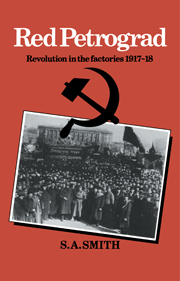Book contents
- Frontmatter
- Contents
- Acknowledgements
- Introduction
- 1 A profile of the Petrograd working class on the eve of 1917
- 2 The tsarist factory
- 3 The February Revolution: A new dispensation in the factories
- 4 The structure and functions of the factory committees
- 5 Trade unions and the betterment of wages
- 6 The theory and practice of workers' control of production
- 7 Deepening economic chaos and the intensification of workers' control
- 8 The social structure of the labour movement
- 9 The October Revolution and the organisation of industry
- 10 The economic crisis and the fate of workers' control: October 1917 to June 1918
- Conclusion
- Notes
- Bibliography
- Index
7 - Deepening economic chaos and the intensification of workers' control
Published online by Cambridge University Press: 11 January 2010
- Frontmatter
- Contents
- Acknowledgements
- Introduction
- 1 A profile of the Petrograd working class on the eve of 1917
- 2 The tsarist factory
- 3 The February Revolution: A new dispensation in the factories
- 4 The structure and functions of the factory committees
- 5 Trade unions and the betterment of wages
- 6 The theory and practice of workers' control of production
- 7 Deepening economic chaos and the intensification of workers' control
- 8 The social structure of the labour movement
- 9 The October Revolution and the organisation of industry
- 10 The economic crisis and the fate of workers' control: October 1917 to June 1918
- Conclusion
- Notes
- Bibliography
- Index
Summary
ECONOMIC CRISIS AND INDUSTRIAL RELATIONS
By midsummer 1917 the crisis in Russian industry was leading to factory closures and rising unemployment. Between March and July, 568 factories – mainly textile and flour mills – employing some 104,000 workers, shut down operations. The Torgovo-Promyshlennaya Gazeta analysed the chief causes of closure as being: first, shortages of cotton, grain and other raw materials; secondly, the ‘excessive’ demands of the workers; thirdly, too few orders; fourthly, lack of fuel; fifthly, declining profitability. The regions worst affected were the Moscow Industrial Region and Southern Russia. After July the scale of unemployment increased, as supplies of fuel and raw materials began to dry up. It was mainly small firms which closed down, but larger firms contributed their share to the pool of unemployment.
Up to October Petrograd was not as badly affected by unemployment as other regions, although there are no reliable data on the number of unemployed in the capital. The number of metalworkers who registered with the union as unemployed rose from 37.4 per day in July to 71.3 in October. Skilled metalworkers could still manage to find jobs, however, so that only about 3% of members of the metal union were unemployed in October. Other industries were worse hit: the shortage of sugar meant that the Petrograd confectionary industry was on the verge of extinction, thus imperilling the livelihood of 4,000 workers. Grain shortages meant that many bakery workers were out of work. In the print industry unemployment was growing rapidly owing to the paper shortage, and by October about 1,000 printers in the capital were out of work.
- Type
- Chapter
- Information
- Red PetrogradRevolution in the Factories, 1917–1918, pp. 168 - 189Publisher: Cambridge University PressPrint publication year: 1983



